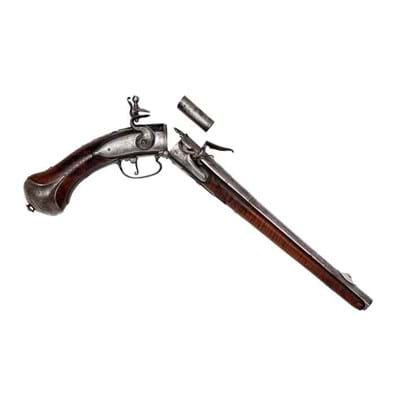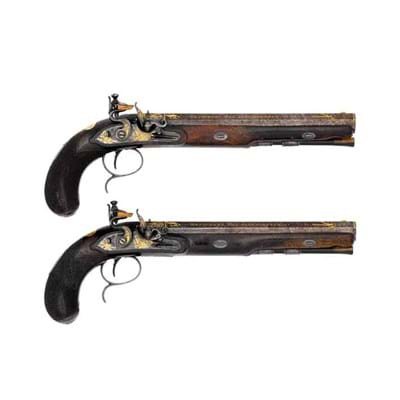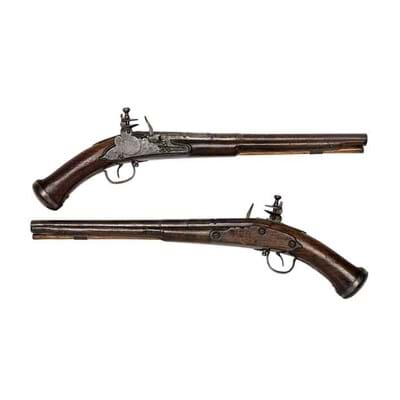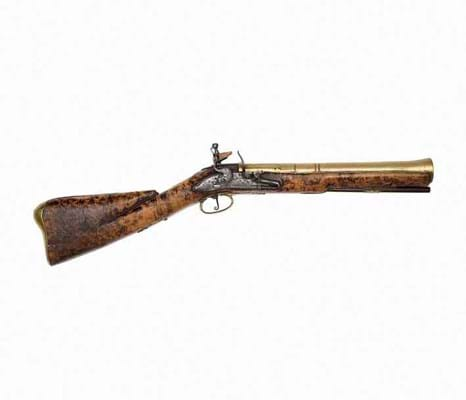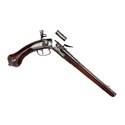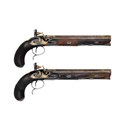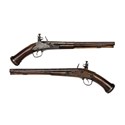For Bonhams Knightbridge's (12/20/25% buyer's premium) November 30 sale the all-important transfusion came in the form of over 50 lots from the collection of Dr Robert Rabett. This was not a collection on the scale of Wiliam Keith Neal or Henk Visser, but it was just what was needed to set the seal on Bonhams' £1.4m sale, contributing nearly £500,000 to that total.
Dr Rabett, who died last year, was one of that fast-diminishing generation who began buying before the Second World War. His collection betrayed a breadth of interest that it would be all but impossible for a collector to indulge today - from truncheons, to small swords, to sporting rifles, to curiosities such as the two cased sets of 19th century cockfighting spurs that went for four times their estimate at £2000.
Within this wide range of interests he had assembled a number of distinct groups of weapons representing different aspects of the history of firearms development. He lent a number of his best pieces to the V&A for an exhibition in 1963 and his collection was exhibited at Rochester Guildhall in 1991-92.
There were some fine English pistols and predictably it was a cased pair of Joseph Manton duelling pistols that produced the top price of the collection. These 40-bore flintlocks were exceptional on many counts, being inlaid with gold and housed in an unusual mahogany case in which they were stored upright along with accessories, including a rare Manton breech-scraper and a mahogany skeleton stock.
These were made for Lieutenant-Colonel Thomas Thornton, whose arms appear on gold escutcheons let into the stocks, and they were last seen at auction at Garrod Turner's sale of the contents of the home of Viscount Ullswater at Campsea Ash in October 1949. Dr Rabett acquired them from an Ipswich dealer in 1951 and subsequently researched the connection with Thornton, a well-known sportsman whose published accounts of his sporting tours are classics in the literature of field sports. His colourful career also encompassed the very latest and best in gunmaking, as well as a string of mistresses.
If these London-made pistols, which had inscriptions in gold along the barrels, appear to owe a lot to the styling of the best Paris makers, that can be explained by the fact that Thornton seemed to be as at home in France as in England and had powerful connections there. In 2006 Bonhams sold one of a pair of complex three-barrelled pistols that Thornton presented to Napoleon in 1802 for £32,000. Again these were decorated in French taste though they were made by Durs Egg of London.
The connection to Thornton added an extra dimension to the sumptuous pair of Manton pistols, and on the market once more after more than half a century, they sold for a mid-estimate £55,000.
Enticing Combinations
A detachable stock also appeared among the accessories cased with a rare pair of 20-bore flintlock saw-handled officer's pistols by Brander & Potts of London which reached £17,000 and there was considerable interest in a cased pair of 25-bore flintlock double-barrelled carriage pistols by Henry Nock, c.1800. These were all-but unique in having lockable safety catches and they came with a note stating that they had been bought from the widow of a flint-knapper in Brandon, Suffolk, who had apparently acquired them when Lacy Scott sold the contents of Brandon House in 1909.
This enticing combination produced a bid of £28,000.
There was also a lot of interest in a much earlier pair of 28-bore English lock holster pistols, c.1660-70, part of a group of guns in the Rabett collection from the Luttrell Armoury at Dunster Castle in Somerset. These bore the crowned-S mark of an unknown maker and had the distinctive dog latch safety catches of the period and were undoubtedly very rare. The cataloguer had suggested £8000-12,000, but the successful bidder had to go to £24,000.
In contrast, precocious sophistication characterised the other major 17th century rarity in the Rabett collection. This was a product of the expert and ingenious Dutch maker Andreas Rheinhold Dolep, who established himself as one of the foremost London gunmakers in the late 17th century.
It took the form of a silver-mounted 22-bore flintlock pistol. This was breech-loading via a hinged drop-down barrel and a reloadable steel cartridge, while the detachable powder pan was fitted with a priming magazine with a sprung dispenser. Such ingenuity came with a £25,000 price tag.
The finest of the percussion pistols was a cased pair of 54-bore rifled target pistols by James Purdey, in fine condition with nearly all their original finish, which sold for £20,000. By coincidence another cased pair of Purdey pistols of the same design but dating from the previous year, 1830, appeared at the Thomas Del Mar sale a week later when they sold for £15,250.
Blunderbusses
Dr Rabett was clearly fascinated by blunderbusses. There were no fewer than 18 in his collection. Most were mid 18th century, some with and some without the spring bayonet that made this psychologically intimidating weapon all the more fearsome.
They mostly sold between £1000 and £2000, and two brass-barrelled examples by John Tow of London, fitted with unusual hollow-ground bayonets, so similar that they almost formed a pair, sold for £5000.
Two examples separated in date by more than a century made rather more. One of these was a very rare early 19th century double-barrelled blunderbuss by Matthew Spencer of Lynn Regis which reached £10,800.
The other was an elegant brass-barrelled weapon made by the London gunsmith John I Sibley, c.1690, with decorative engraving and brass mounts and a full maple stock with simulated figuring which caused some excitement when it reached £15,000.
While English guns predominated, there were a couple of more exotic lots among them. From mid-18th century Portugal came a pair of 20-bore silver-mounted miquelet holster pistols by Jose Antonio of Vilanova in the Algarve, dated 1746. These were of superior quality and in good order and they sold for £19,000.
From rather further afield came a late 18th or early 19th century Indo-Persian Pesh-kabz dagger with a beautifully chiselled blade, walrus ivory grips and the original scabbard which made £22,000.

